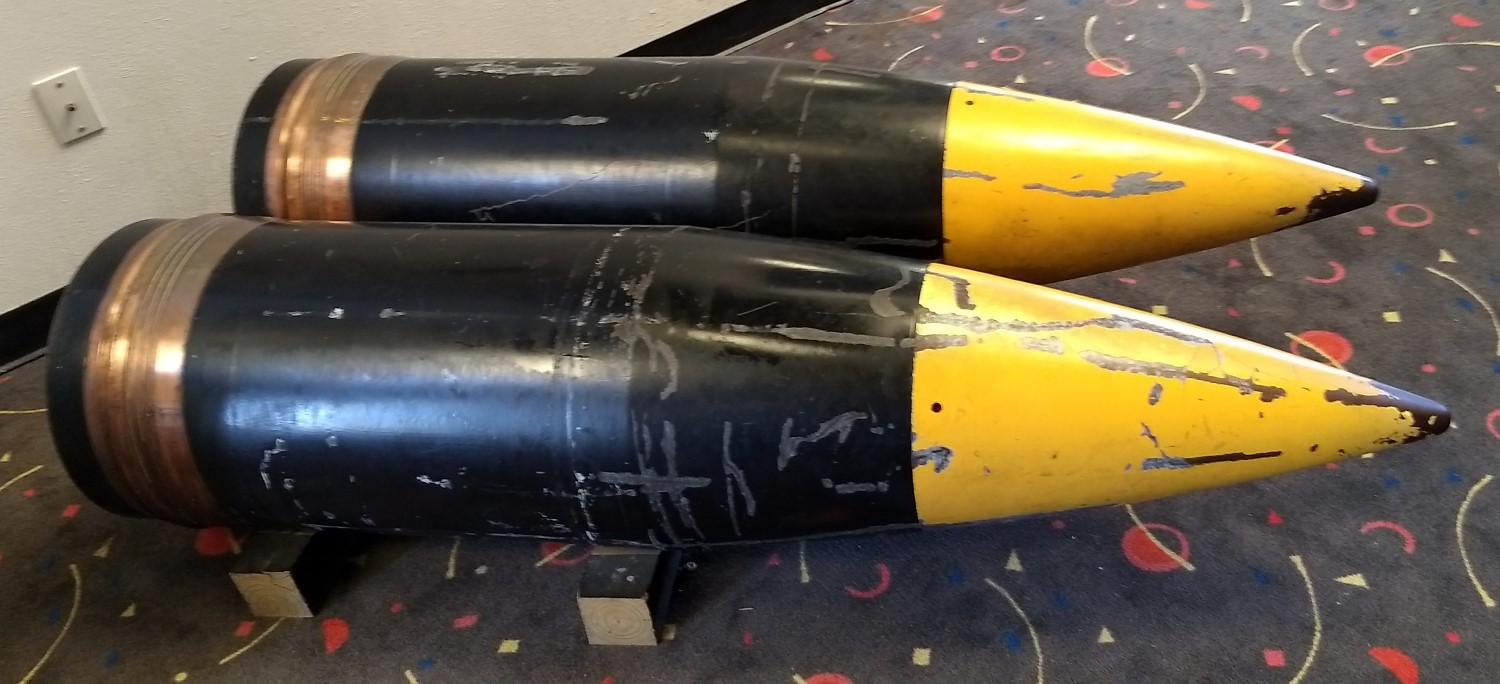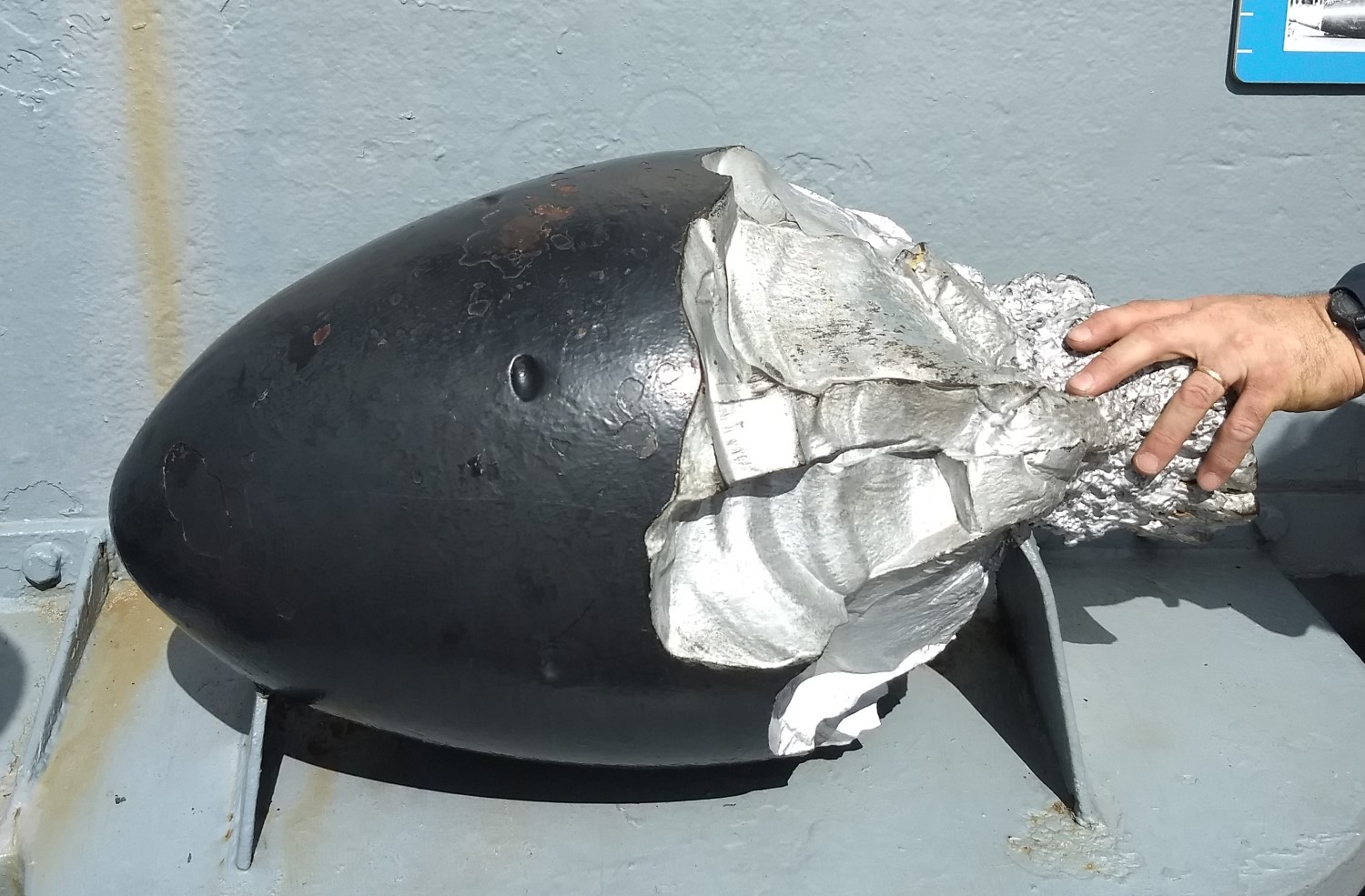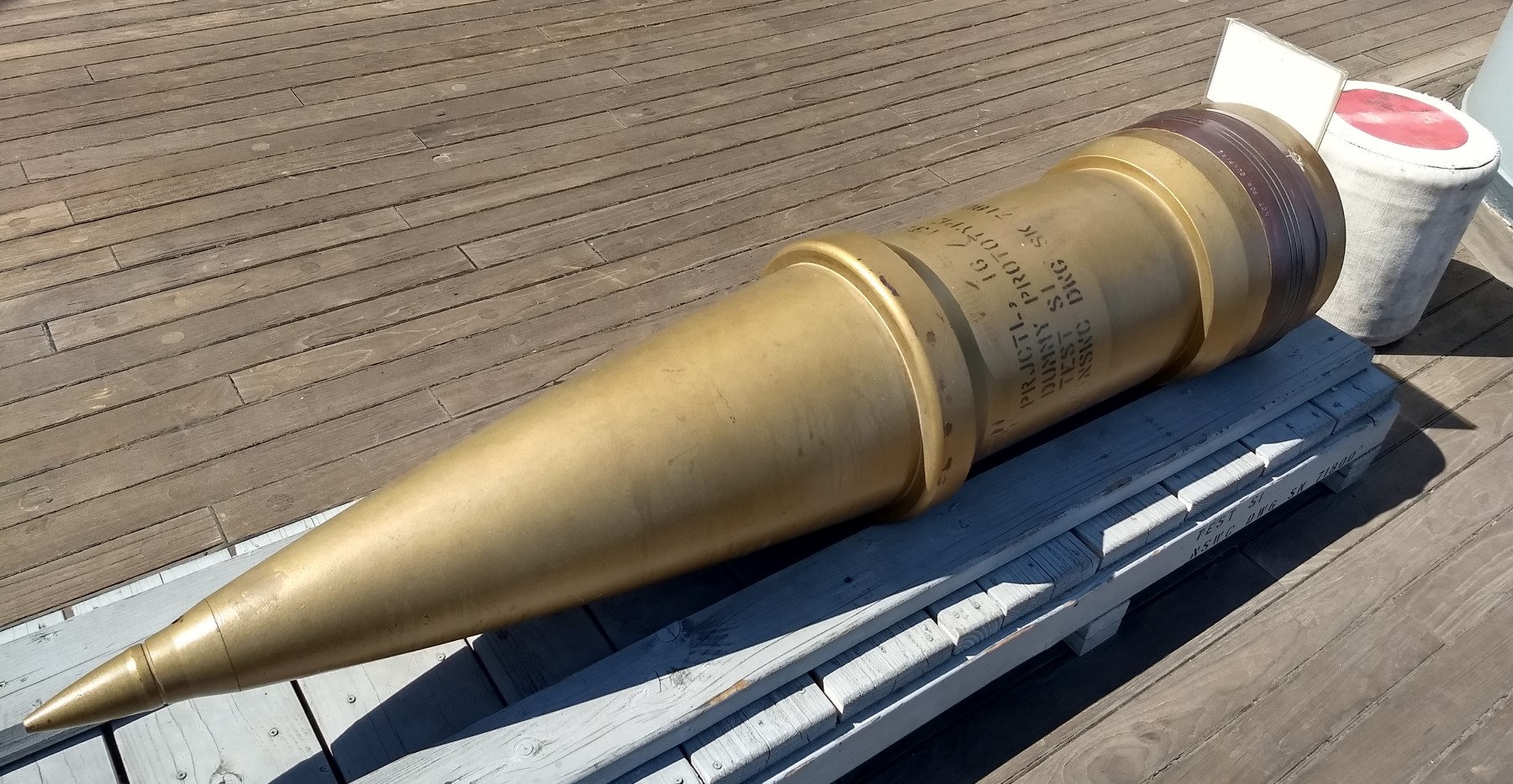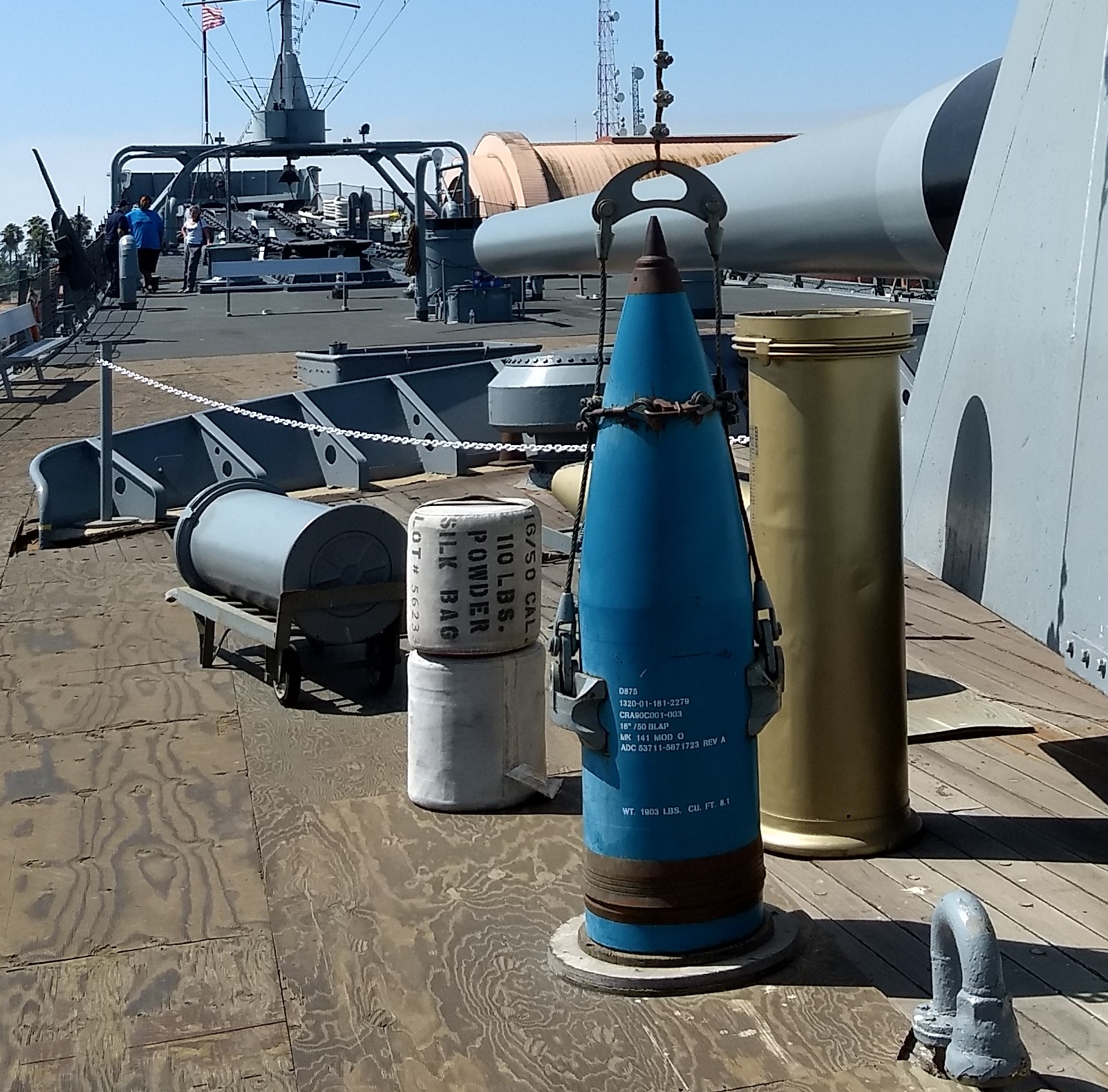While the basic shape of naval armor-piercing projectiles was largely set in the years 1905-1920, and most nations entered WWII with projectiles that were improved only in detail over the shells they had used then, two nations made radical departures. The Japanese optimized their shells for underwater hits, a process discussed last time, while the USN developed the most effective armor-piercing (AP) shells the world has ever seen.

A pair of 2,240 lb Mk 5 16" AP target shells at Science Museum Oklahoma1
The original shells for the 16"/45 guns of the Colorado class were fairly conventional projectiles of 2,100 lbs. In the 1930s, the Bureau of Ordnance developed a slightly heavier, stronger shell of 2,240 lbs, with a consequent increase in penetration. It also had an improved AP cap, hardened so that it would not be torn off in oblique impacts and would instead crack the face-hardened layer of the armor, digging a hole that kept the projectile's nose in like a center punch. This was the shell that was used to develop the immune zones for the South Dakota and Iowa classes, but before any of those ships were completed, BuOrd had come up with something even better, the amazing 2,700 lb Mk 8, known as the "superheavy" shell.2 The 20% increase in shell weight reduced muzzle velocity, to the point that belt penetration stayed largely the same, but deck penetration, more likely to matter at the long ranges the USN planned to fight at, rose by up to 25%, and immune zones collapsed. The zone for the Iowas went from 13,600 yrds to 5,300 yrds against the 16"/45 gun. In late 1944, the improved AP Mk 8 Mod 6 entered service, with improved hardening and an altered shape to increase penetration at long range by another 25%. It was considered so effective that the battleships in the Pacific were ordered to turn in their existing shells and rearm as quickly as possible. In fact, this shell, fired from a 16"/50 gun, was considered broadly equivalent to a conventional 18" weapon.3

An actual 16" AP shell on display at Batfish
The superheavy 16" shells were only used by the three American treaty classes, as the shell hoists of the older Colorado class could only take shells up to 64", while the superheavy shells were 72" long. This also affected the development of the American high-capacity (HC) shell, which was limited to 64", and thus 1,900 lb, for the sake of commonality. It was only introduced in late 19424 but formed the vast majority of 16" shells fired in anger. Both shells had light bursters for their weight, with 8% for the HC and only 1.5% for the AP, but there were few complaints about their effectiveness in action.

The nose of a 16" shell fired by Massachusetts at Casablanca in 1942
But why did no other nation follow the USN's lead and introduce a superheavy shell of this sort? The basic concept that a longer, heavier shell would pierce armor better is obvious, so there must have been something, but this is a topic on which my books are strangely silent. While the problems of upgrading an existing turret might have prevented the replacement of older shells,5 there was no such obstacle on new-build ships, and yet no other nation made such strides in shell weight. One possible explanation is that these nations were more focused on short-range combat, where lighter shells are equally effective, but even this doesn't seem fully satisfactory because the British and French designed their ships in the expectation of long-range combat. A more likely explanation has to do with the mechanics of armor penetration. Longer, heavier shells are more effective if they remain intact during penetration, but the heavier back of the shell places more stress on the front, increasing the chance of the shell shattering.6 A stronger shell could be made longer and more effective, and BuOrd appears to have managed to develop a much more effective combination of metallurgy and heat treatment than any other power. If there had ever been a clash between opposing battlefleets, this might have given the Americans a decisive advantage.7

A 16" subcaliber projectile aboard Iowa
The story of the battleship shell didn't quite end with WWII, either. In the 1950s, the US developed a 16" nuclear shell, the Mk 23 Katie, which I've discussed elsewhere. And in the 1980s, when the Iowas were reactivated, more new shells were developed. The only one to enter service was the Mk 144, which had the shape and weight of an HC shell, filled with 400 submunitions. Each of these was a small bomblet about the size of a grenade, and capable of doing significant damage to personnel, light vehicles, and aircraft. Another submunition projectile, the Mk 146, would have carried 666 smaller bomblets, but never entered active service.8 A 72" HC shell, weighing 2,240 lb, was investigated, but never put into service. But the most notable shell developed was the Mk 148. It was a 13.65" sub-caliber shell, held in the barrel by a sabot.9 It would have been able to carry its submuntion payload over 70,000 yards, almost twice the range of conventional shells. It would probably have been laser-guided, and there was also discussion of laser-guiding 16" projectiles, but as far as I'm aware, none were ever deployed operationally.

A 16" HC target shell aboard Iowa
The superheavy shell is a particularly interesting case of an apparently minor technological innovation, an improvement in shell metallurgy, allowing much bigger things. They gave American battleships unmatched long-range punch, an important piece of what were ultimately to be the best battleships ever created. Later, the US kept the Iowas in service long after their brethren had been sent to the scrapyard, and developed a number of specialized shells that simply could not have been built during the heyday of the type.
From the introduction of the explosive shell onward, the projectiles available to battleships were a critical factor in their effectiveness in action, even if this wasn't always apparent to outside observers. It only rose to prominence when there was a major failure, such as that of the British armor-piercing shells at Jutland. Later developments saw both marginal improvements to existing projectiles and radical departures for new methods and roles. Some of these turned out very well and added new capabilities to the battleship, while others ended up as useless oddities. But in the last analysis, a battleship is a device for delivering high-velocity steel and explosives to the enemy, and it would be useless without shells.
1 All photos in this post are from my collection, weirdly enough. ⇑
2 It's worth pointing out that the 16" wasn't the only weapon to benefit from superheavy shells. 12", 8" and 6" guns also received heavier shells that gave them substantial advantages over similar-sized weapons from other countries. ⇑
3 A tidbit, found in the Bureau of Ordnance history of WWII (p.263) is worth sharing: "Behind 1 minute of fire [of a battleship with 2700 lb shells], according to a statistician, lay 3600 man-hours of labor required for the production of the "100,000 pounds of alloy steel ... the 1300 pounds of carbon steel . . . and the more than two-thirds of a ton of copper and brass expended."" ⇑
4 Do note that this means it was the result of prewar planning, largely as a result of late 30s exercises in amphibious landings. I do suspect fielding was rushed as a result of bad experiences during Operation Torch, when Massachusetts found her bombardments to be mostly ineffective because she was firing AP. ⇑
5 It does bear pointing out that the Japanese actually went to the trouble of lengthening their shell hoists to accommodate the Type 91s, and yet didn't bother to increase the weight of the projectiles. ⇑
6 BuOrd actually tested a 3,150 lb shell (40% overweight) alongside the initial tests of the 2,700 lb shell. It was not adopted because it was too likely to break up during oblique impacts. ⇑
7 A secondary problem was aerodynamic stability. A longer shell is more difficult to stabilize, and might require different rifling in the gun. ⇑
8 I'm not really sure why two different submunition rounds were built. The Mk 146 may have had DPICM submunitions, but my sources aren't entirely clear. ⇑
9 Sabot shells had previously been examined in the late 60s, most notably using surplus 11" shells left over from the Army's atomic cannon project, but none ever saw service aboard New Jersey off Vietnam, contrary to some reports. ⇑

Comments
I'm intrigued by the 13.65″ sub-caliber shell that was intended to be guided and with a range of 70 km.
That's getting towards the sort of size and range that the new railguns are supposed to be achieving.
Which brings up the question: If battleships had stayed in development (because reasons, hand-wave furiously)... would we have seen cannon getting larger and larger, or would they have gone smaller and longer range? (Guidance, both laser and radar, eventually GPS, are taken for granted.)
The railguns aren't going to fire 13.65" projectiles. The actual projectiles are going to be more like 35 lb. But yes, it's broadly in the same range. Higher ballistic coefficient does a lot.
I suspect that battleship guns were getting towards the limits of the practical. Handling bigger and heavier shells is hard, and at some point, the gun overmatches armor well enough that there's no reason to push size up, particularly because the fire control technology of the day means you want a decent salvo size and a good ROF, both of which really big guns (I've seen a couple plans for 20" weapons) make hard to do.
I suspect the answer is cost, and to a lesser extent strength, but did anybody experiment with increased density materials? DU is obviously out because uranium hadn't been produced at scale, but it seems like a steel jacketed molybdenum or lead round would have meaningfully increased weight/density of the overall shell with then present technology.
Not that I'm aware of, and I suspect you're right on the reasons, too. Lead is just going to squish when it hits steel, particularly as strength was already a controlling factor in a lot of cases. I'm not sure about molybdenum. I'd guess it was a matter of cost, or possibly one of technology. I have no idea what the state of the art in molybendum fabrication was in 1940, but I wouldn't rule out "we can't make it in pure form", particularly given the high melting point.
Several nations made limited use of tungsten and tungsten carbide in anti-tank ammunition, usually in composite rounds ("APCR" or "HVAP") with a hard, dense penetrator core inside a light aluminum-alloy jacket. The Germans even used natural undepleted uranium in this role later in the war, as their tungsten supplies were cut off by blockade and diplomacy and their nuclear program was going nowhere.
This was as you suspect far too expensive for battleship-scale use, and really too expensive for antitank use except that nations kept finding out that the antitank guns they had ordered in 1939 were not penetrating the tank armor they were encountering in 1942. Also, the APCR/HVAP construction doesn't allow for a bursting charge, which is OK when you are shooting at something as densely packed with vital and/or pyrotechnic goodies as a tank, but not adequate for use aginst mostly-empty-space warships.